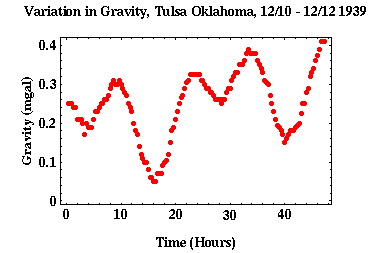Tides
Definition
Tidal Effect - Variations in gravity observations resulting from the attraction of the moon and sun and the distortion of the earth so produced*.Superimposed on instrument drift is another temporally varying component of gravity. Unlike instrument drift, which results from the temporally varying characteristics of the gravimeter, this component represents real changes in the gravitational acceleration. Unfortunately, these are changes that do not relate to local geology and are hence a form of noise in our observations.
Just as the gravitational attraction of the sun and the moon distorts the shape of the ocean surface, it also distorts the shape of the earth. Because rocks yield to external forces much less readily than water, the amount the earth distorts under these external forces is far less than the amount the oceans distort. The size of the ocean tides, the name given to the distortion of the ocean caused by the sun and moon, is measured in terms of meters. The size of the solid earth tide, the name given to the distortion of the earth caused by the sun and moon, is measured in terms of centimeters.
This distortion of the solid earth produces measurable changes in the gravitational acceleration because as the shape of the earth changes, the distance of the gravimeter to the center of the earth changes (recall that gravitational acceleration is proportional to one over distance squared). The distortion of the earth varies from location to location, but it can be large enough to produce variations in gravitational acceleration as large as 0.2 mgals. This effect would easily overwhelm the example gravity anomaly described previously.

An example of the variation in gravitational acceleration observed at one location (Tulsa, Oklahoma) is shown above**. These are raw observations that include both instrument drift (notice how there is a general trend in increasing gravitational acceleration with increasing time) and tides (the cyclic variation in gravity with a period of oscillation of about 12 hours). In this case the amplitude of the tidal variation is about 0.15 mgals, and the amplitude of the drift appears to be about 0.12 mgals over two days.
*Definition from the Encyclopedic Dictionary of Exploration Geophysics by R. E. Sheriff, published by the Society of Exploration Geophysics.
Gravity
- Overviewpg 12
- -Temporal Based Variations-
- Instrument Driftpg 13
- Tidespg 14
- A Correction Strategy for Instrument Drift and Tidespg 15
- Tidal and Drift Corrections: A Field Procedurepg 16
- Tidal and Drift Corrections: Data Reductionpg 17
- -Spatial Based Variations-
- Latitude Dependent Changes in Gravitational Accelerationpg 18
- Correcting for Latitude Dependent Changespg 19
- Vari. in Gravitational Acceleration Due to Changes in Elevationpg 20
- Accounting for Elevation Vari.: The Free-Air Correctionpg 21
- Variations in Gravity Due to Excess Masspg 22
- Correcting for Excess Mass: The Bouguer Slab Correctionpg 23
- Vari. in Gravity Due to Nearby Topographypg 24
- Terrain Correctionspg 25
- Summary of Gravity Typespg 26